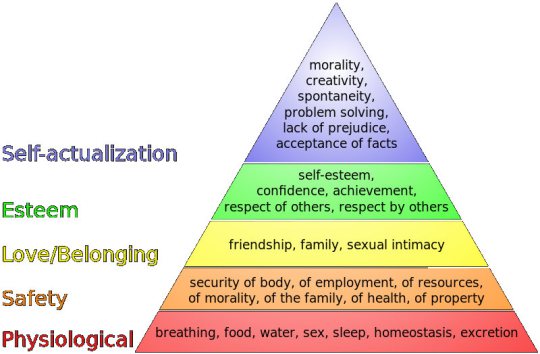Maslow’s Hierarchy of Needs
Introduction
Abraham Maslow proposed the theory of the Hierarchy of Needs in his 1943 paper “A Theory of Human Motivation” in Psychological Review.
The Hierarchy of Needs
Most often expressed in a neat diagram, the hierarchy of needs represents the six sequential types of motivation that drive human actions. At our most basic levels of motivation, we strive to protect ourselves physiologically by finding or creating shelter and sourcing water and food. The hierarchy takes us through five levels that end at the most existential and intellectual of motivations – that of self actualisation – our drive to fulfil our potential. Once this is achieved, we can tackle the elusive and un-diagramed sixth level – self transcendence. For all practical purposes, the use of Maslow’s Hierarchy usually only includes the first five levels.

The Maslow Hierarchy of Needs in practice
In practice, rather than seeing the different levels as motivations, we might think of these as needs to be met. So, for example, if we are thinking about designing an educational endeavour, we might consider how all the five levels are going to be provided for within the endeavour. So let’s imagine we are going to plan a whole day exercise where our students are going to run an activity at a science fair. The activity is for families and children, and during the activity, the students will be acting as teachers to help the children and families complete a creative craft task.
Considering the needs of the students
Physiological – the activity will be lasting all day – the students will need food and drink, and will need some time for breaks. The activity will be in a marquee – this will only provide basic shelter – we should remind the students to bring outdoor gear such as jackets/jumpers in case it is cold.
Safety – the students will be undertaking a craft activity, there will be scissors and lots of craft material. Let’s not take ‘dangerous’ tools like craft knives and glue guns. The activity will be in a marquee at the fair – we should look out for hazards like cables and electricity – especially if there are weather issues.
Love/Belonging – the students will be working together in a peer group – they have worked together before and there are no known issues with friendships/standing arguments within the group. I will be supervising and I know all the students and they trust me (I hope). I will be able to provide additional support on the day.
Esteem – the activity will allow the students to take roles of responsibility with regards to running the activity and they will be seen as ‘expert’ or ‘knowledgeable’ by the participating children and families. Let’s make sure the students are well briefed so that they are not put in a position where they don’t know what to do, or what to say (we don’t want to compromise their sense of esteem and knock their confidence).
Self Actualisation – this activity will be a challenge for the students – they will taking on responsibility for the success of the event, and might be working on communication or interpersonal skills that are challenging for them in this context.
We could similarly work through the levels to consider the needs of the participating children and families.
Reference and further reading
Maslow, A.H. (1943). “A theory of human motivation”. Psychological Review. 50 (4): 370–96.

[…] the most well known use of the term ‘self actualisation’ is in Maslow’s Hierarchy of Needs. This is a summary of the basic needs of human beings that must be fulfilled for our survival. […]